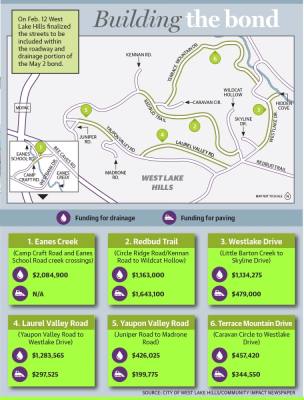The bond is centered on the city’s major infrastructure needs and encompasses a proposition for a new City Hall and police building as well as a proposition devoted to drainage and pavement projects. Various roadways, including Wildcat Hollow and Camp Craft Road, are subject to frequent floods and continuous maintenance, according to officials.
The neighboring city of Rollingwood faces similar challenges related to its aging infrastructure, according to a report by engineering firm K. Friese & Associates, which highlighted the city’s major flooding and drainage concerns.
Both cities are dealing with issues related to flood damage in their respective municipal buildings, and in Rollingwood’s case, black mold has been found. The mold led West Lake Hills to dedicate $12 million of the bond to the construction of a larger, safer and more accessible municipal building, Anthony said.
While Rollingwood has not taken official action on a bond, the city is devoting funds and extensive research toward evaluating the need for citywide upgrades, Mayor Michael Dyson said.
Failing facilities
Officials have frequently discussed the prospect of a capital improvements bond from inside the aging chambers of the West Lake Hills City Hall building, which was built as a residential property in 1982.
Anthony said the structure has faced numerous issues, including flooding, multiple roof repairs, electrical issues, accessibility issues and a number of building code compliance violations. She said when the city contracted a study by Brinkley Sargent Wiginton in 2018 it became increasingly clear that repairing the existing structure was impractical.
“People may be under the impression that we’re a small city [and that] we’ve got adequate space,” Anthony said. “They don’t realize that our offices are carved out of closets and hallways.”
The architectural study concluded that the municipal building was in a state of disrepair, with the building’s connected police department presenting the largest shortcomings.
Police Chief Scott Gerdes said and his officers and staff work through these challenges on a daily basis. The building contains a single locker room for both male and female officers, lacks the necessary electrical abilities to charge devices and contains no fire sprinkler system.
Gerdes has previously told Community Impact Newspaper his department has no proper interview room or privacy for citizens filing police reports, and that is still the case. If a resident needed to report a crime, he or she would do so in the building’s lobby, next to individuals looking to pay their speeding tickets.
Rollingwood’s officers also struggle with space and structural problems. In 2016, the city found mold in the police building attached to City Hall, forcing the department into a portable building on the property, out of which officers still operate.
The discovery drove the discussion on the overall inadequacies of the building, eventually leading the city to contract a facilities study by Brinkley Sargent in December 2017. The study concluded that the spatial needs of the combined municipal buildings are 3,896 square feet less than what would be considered adequate.
In terms of aging infrastructure, both cities have also conducted studies highlighting issues related to roadway and drainage improvements.
“Critical mass sounds a little dramatic,” Dyson said. “But for lack of a better word, we realized any number of our infrastructure needs have reached that.”
Roadway and drainage repairs
Discussion and assessment of potential drainage improvements are among the first priorities for Rollingwood, Dyson said, adding that the city will tackle drainage plans first, then roadways, then water line repairs.
The study by K. Friese identified 23 potential drainage projects within city limits, including repairs on Bee Caves Road, Edgegrove and Nixon Road. The projects, which totaled $19.72 million, were based on a variety of factors including resident input.
Dyson said the study, presented at the Feb. 19 Rollingwood City Council meeting, provided a detailed scope of the city’s drainage ecosystem and took into account public surveys, fieldwork and hydraulic modeling.
“What [the study] intended to provide is a kind of overarching foundational conversation supported by a lot of engineering data to help us understand exactly what our challenges are with regard to drainage,” Dyson said.
Prior to implementing the report’s suggestions, he said, more data is required regarding the city’s easements and rights of way within its roadway system. This information would clarify the boundaries between city and private property.
West Lake Hills also contracted K. Friese to examine the scope of the city’s critical roadway and drainage projects. The list of potential repairs was debated and edited for months prior to approving the total cost of $10 million.
The most expensive projects include drainage repairs on the Eanes Creek low-water crossing, which totals $2,084,900, as well as both drainage and roadway repairs on Redbud Trail at $2,806,100.
In total, the bond encompasses six roadway and drainage projects, which Anthony referred to as “big-ticket items” too costly to be funded by the city’s general fund.
“Sooner or later you’re gonna have to spend a significant chunk of change to address our infrastructure needs,” Anthony said, adding that minor fixes over the years have only served as temporary Band-Aids.
Finding funding
The West Lake Hills community has benefited from an arguably low tax rate for years, Anthony said. The rate of $0.07 per $100 valuation is significantly lower when compared with cities of similar median home value, according to City Administrator Travis Askey.
Anthony said keeping up with the city’s aging infrastructure needs is not feasible at the current rate, and as a result, seeking a bond to fund the major projects was the best option.
The rate could potentially double if both bond propositions pass, and Anthony noted that even if that occurs, the city will still operate on a lower tax rate than comparable municipalities.
“In some ways, we’ve done ourselves a disservice by keeping the property tax as low as we have for as long as we have and making the assumption that sales tax revenue can carry us,” Anthony said.
The study by K. Friese originally called for a bond with a larger price tag; however, the city evaluated the data and decided to complete a number of smaller projects out of its general fund.
Dyson noted that as the city continues to build upon its own data pool, Rollingwood is also examining innovative funding options when developing an infrastructure plan.
“I would argue that a bond election is our last resort,” Dyson said, adding that a number of the city’s drainage projects may be eligible for funding through federal or state grants.
Rollingwood is also looking to bolster its commercial district along Bee Caves Road to increase revenue. The city’s funding is comprised of an 80% property tax and 20% sales tax ratio, and Dyson said he would like to see a more balanced revenue stream.
Officials recently commissioned what Dyson called a robust study from The Retail Coach, a retail consulting firm that provides market research and development strategies for city governments and other entities.
Information from that study shows one takeaway focuses on planning and zoning inconsistencies along Bee Caves that are potentially hindering potential and current business. The idea of mixed-used and multilevel developments was also considered.
“It's maybe not just enough to address aging infrastructure, but in fact, we should probably consider new infrastructure,” Dyson said.
Rollingwood’s recent data-driven studies have provided the city with a strong overview of its current needs. According to Dyson, the conversation on project design and finances is on the horizon.
“Now we can start having a conversation,” Dyson said. “Where do our needs and our expectations come into play with the actual dollars required to undertake these things?”
Emphasizing community outreach
Dyson has stressed the need for a thoughtful and meticulous approach when tackling these infrastructure projects. While the city is acting on this plan there is no desire to rush the process, and Rollingwood will continue with additional studies and analysis on its infrastructure plan, he said.
“The time is right. The question is, what is it right for?” Dyson said. “That’s the conversation the community needs to have, and it’s on us to give them the data points.”
Dyson emphasized civic engagement as an invaluable component of any local government, and said moving forward Rollingwood officials hope for an open conversation with the community regarding its infrastructure needs.
Transparency and community involvement have been frequently discussed in association with the bond for West Lake Hills, and City Council is putting together a political action committee tasked with educating residents throughout the city and advocating for the bond.
To help place more emphasis on community participation, council will also continue to hold open houses prior to the May 2 election. Anthony said this bond is a new venture for both the city and its residents, and working together is the best option.
While the bond may be alarming to residents at first, Askey said, the need to invest in the city’s infrastructure has been a long time coming.
“I don’t know any other municipality in Texas that’s gone 60 years of their incorporation that has never issued debt,” Askey said. “It’s unheard of.”
Dyson said Rollingwood officials have also prioritized community outreach—that it is the city’s duty to obtain the data and make it consumable for residents.
“This isn’t a community for me. This isn’t a community for you. This is a community for us,” Dyson said. “Hopefully more often than not our needs align.”







